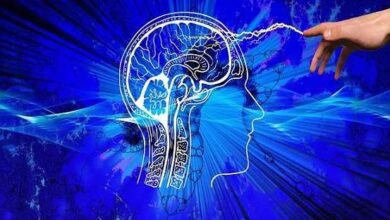Right cerebral hemisphere structure characteristics and Features
Hemisphere of the brain
In popular culture, the belief that the cerebral hemispheres differ in their characteristics is widespread. The right hemisphere has traditionally been associated with the artistic , while the left hemisphere is considered to be more analytical, involved in aspects such as mathematics and verbal language. In this article we will provide you information about the Right cerebral hemisphere.
Although many atrocities have been said about what each of the hemispheres do, the truth is that both brain structures do differ in terms of their characteristics and functions.
In this article we are going to talk about the right cerebral hemisphere , what are its most notable characteristics and functions, in addition to describing a syndrome related to this structure and its symptoms.
Before going into more detail about the particularities of the right hemisphere, it is first necessary to explain what a cerebral hemisphere is, and what role it has in the nervous system of human beings.
The word hemisphere comes from the Greek words ‘hemi’ (‘half’) and ‘sphera’ (‘sphere’) and, when we talk about the cerebral hemispheres, we refer to each of the two main portions that make up the brain.
The hemispheres are inverse of each other, but not inversely symmetrical. These structures are separated by a line called the interhemispheric fissure , and that is why we speak of the left and right hemispheres. In the depths of this fissure is the corpus callosum that connects both hemispheres. Right cerebral hemisphere characteristics
How is the right cerebral hemisphere structured?
The right cerebral hemisphere constitutes the upper and right half of the brain. This structure, like its left counterpart, encompasses half of the five large lobes of the brain:
- Frontal lobe
- Parietal lobe
- Temporal lobe
- Occipital lobe
- Insula
As we have already mentioned, both hemispheres are separated by the interhemispheric fissure, also called the longitudinal cerebral fissure. In the deepest part of this fissure is the corpus callosum , a structure of nerve fibers which connects both hemispheres. Since both hemispheres need to share information with each other constantly, the corpus callosum is a structure that does a great job.
Like other brain structures, the right hemisphere is protected by three layers:
- Dura mater : outermost membrane and closest to the skull, allows the brain to be well connected to the bone.
- Arachnoid : between the dura mater and the pia mater.
- Pia mater : innermost membrane, contiguous with brain matter.
Characteristics
Although structurally similar to the left hemisphere, the right hemisphere has different characteristics. The left hemisphere is considered the most analytical, while the right is attributed more creative characteristics. Below we will see in more detail which are the most representative characteristics of the right hemisphere of the brain :
1. Musical
Playing an instrument, identifying precisely what note is being heard, or quickly learning the rhythmicity of a melody are all aspects of the right hemisphere.
2. Synthetic
That the right hemisphere has a synthetic processing means it allows to postulate hypotheses and propose ideas , with the intention of contrasting them, seeing if they are true or not and, if not, proposing new ones.
The generation of new thoughts does not necessarily have to be linked to the veracity of a fact. You can come up with something new simply with the intention of being original.
3. Non-verbal
To say that the right hemisphere is a structure that is not involved in language is not entirely true. This human capacity involves various brain areas, some of them being on the right side. However, verbal aspects such as speech and literacy are more typical of the left hemisphere.
In the right hemisphere there is the ability to analyze those non-verbalized aspects of language , such as facial gestures. Right cerebral hemisphere characteristics
4. Holistic
The proper processing of the right hemisphere is to adopt a broad vision of a problem, instead of choosing to carefully analyze each of the details that make it up.
Thus, it analyzes a specific stimulus in an integrated and global way. For this reason, the right hemisphere is the structure behind, mostly, in artistic and innovative processes.
5. Geometric-spatial
Although last but not least, the geometric and spatial abilities of the right hemisphere represent the most remarkable cognitive abilities of this structure .
Thanks to this, it is possible to order the space, generate mental images or build geometric structures.
Features
Related to the aforementioned characteristics, the right hemisphere is capable of conceiving strategies in a broad way, integrating the details that make up a situation or problem and allowing a holistic view of what is happening . Thus, it is possible to see images, hear sounds and perceive smells as a whole.
1. Spatial orientation
Thanks to the right hemisphere it is possible to orient oneself in physical space. It allows to know what object is being seen or where it is from aspects such as color, shape or other characteristics present in the environment. Right cerebral hemisphere characteristics
Placing yourself in space, identifying objects, and recognizing the faces of loved ones are just some of the capabilities offered by the spatial capabilities of this hemisphere.
2. Stimulus processing
In short, each cerebral hemisphere is in charge of elaborating and processing the stimuli captured in its opposite half-body (half of the body). The right hemisphere is responsible for ‘feeling’ the stimuli that have been given in the left part of the body .
Thus, when we are touching something with our left hand, it would be the right hemisphere that would be in charge of processing the associated sensation.
3. Emotionality and non-verbal aspects
The right hemisphere takes on a great role in the elaboration of feelings .
In addition, when analyzing them, he opts for more integrative tools instead of analytical ones, unlike his counterpart, the left hemisphere.
On the other hand, it is able to identify non-verbalized aspects such as prosody in language (tone with which it is spoken, expressiveness …).
Right hemisphere syndrome
Sometimes it happens that one of the hemispheres suffers an injury . These injuries affect the person’s cognitive abilities, which may imply a greater or lesser degree of discomfort after having suffered the accident. Right hemisphere syndrome is a neurological condition in which the white matter of this brain structure has been damaged. It can also be due to injuries that occurred in the pathways that connected with the left hemisphere.
In most people, the right hemisphere is usually the least dominant hemisphere. As we have already commented previously, this structure is the one that presents some characteristics more related to non-verbal communication. Thus, an injury in this hemisphere involves problems such as difficulties in interpreting facial gestures and postural variations.
With facial expression, people indicate if we are happy, angry, sad or disgusted by something in a very clear way. Postures are more subtle forms of emotional expression, and can indicate discomfort, nervousness, or being defensive. Although useful, verbalized language does not allow us to fully communicate people’s feelings , and may even indicate the opposite (eg, when it is said that you are not nervous but your legs are shaking).
For reasons like these, the right hemisphere syndrome implies a great degree of affectation in the life of the person, since it makes emotional recognition difficult. In addition, it also implies not being able to express with the proper emotional and non-verbal language what feelings are being felt, implying a clear impact on social life. Right cerebral hemisphere characteristics


